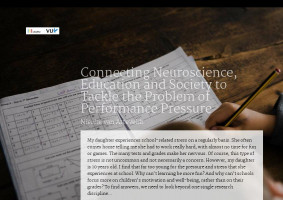My daughter experiences school-related stress on a regularly basis. She often comes home telling me she had to work really hard, with almost no time for fun or games. The many tests and grades make her nervous. Of course, this type of stress is not uncommon and not necessarily a concern. However, my daughter is 10 years old. I find that far too young for the pressure and stress that she experiences at school. Why can’t learning be more fun? And why can’t schools focus more on children’s motivation and well-being, rather than on their grades? To find answers, we need to look beyond one single research discipline...
Many issues related to our children’s education are complex and rooted in different intertwined layers. In science, these layers are called levels and we distinguish between, for example, the individual, social and societal levels. Each individual child goes through a unique developmental trajectory during their school period. Their neurobiological developmental processes are strongly shaped by their social environment: interactions with peers, siblings, parents and teachers. Influences are also exerted at the macro level by teaching practices (school systems) and the dominant values and goals within a society (the sociopolitical context).
Let’s go back to the example of my daughter. I remember her starting primary school as a happy and confident little girl who was eager to learn. Over the years, we have seen her losing motivation for schoolwork and becoming more worried about her performance. And my daughter is not an isolated case, as the Dutch Health Behaviour in School-Aged Children (HBSC) study convincingly demonstrates. HBSC’s 2022 report shows a concerning tripling of experienced performance pressure among Dutch youth over the last two decades. This increased pressure is accompanied by mental health problems, especially in girls.
Because of the complex and multi-levelled nature of a child’s development during the school period, we need to connect research from different fields and traditions to get to a better understanding of wicked problems such as performance pressure.
Connecting neuroscience, education and society: why?
To understand why many children feel more stressed about their performance than they enjoy learning, we need to understand the interplay between the development of their brains and minds, school practices and societal values. During the entire school period, important developmental processes occur in a child’s brain, shaping their behaviour and learning mechanisms. At the same time, brain development is influenced by the inputs a child receives, often in interaction with others. During this developmental interplay, certain children maintain their intrinsic motivation to learn new things, while others start to focus more on performing well and comparing themselves to peers. This focus is also shaped by their social context: the norms in their classrooms for example, and the messages they get at home. What do teachers and parents emphasise? In the current western meritocratic societies, the emphasis is often on measurable achievements, or in other words, getting good grades in comparison to others, instead of improving against a child’s own benchmark.
The influences at the diverse levels are often studied in isolation, but this inevitably leads to incomplete answers. This is because the interactions between the different levels lead to emergent properties. This means we cannot understand the complete problem by understanding its isolated parts. In other words, only studying brain development will not provide answers, and neither does only studying sociological processes.
The risk of focusing on one level and being blind to other levels can be exemplified again by my daughter. Cases like hers might urge research at the individual level, for example to investigate predictors of stress resilience, and interventions to increase it. But is it really an individual problem? Shouldn’t the research be focused on why so many children experience performance pressure, with the aim to intervene at a more societal level? To find the right questions to address, and the right impacts to pursue, we need to integrate research on all the relevant levels, from the start.
Connecting neuroscience, education and society: how?
Although the need to combine forces in interdisciplinary research has long been recognised, this is easier said than done. To integrate different disciplines and traditions, scientists first of all need to get out of their comfort zones and be exposed to different perspectives. But being exposed to different ideas does not automatically lead to synthesis. We need to know what to make of these ideas and how to combine them with our own. For this, we need to ask a lot of questions. Do the same terms have the same meaning in different fields? What assumptions are being made?
An even more essential counterpart of asking questions, is listening. Very inspiring in this context is Stephen Covey’s Seven Habits Model, in particular habit 5: ‘Seek first to understand, then be understood’. Too often, we are focused on being understood and making ourselves heard. But the order suggested by Covey, to first understand the other, is essential for interdisciplinary work.
In conclusion, only through connecting the individual and context levels of research can we achieve the interdisciplinarity required to reduce performance pressure and improve the well-being of our youth. In the meantime, I will continue to juggle all levels of influence in an effort to prevent a downward spiral, at least for my daughter.
The above text was originally published as part of the Connected World - Insights from 100 Academics on How to Build Better Connections. You can read and download the original publication here.

prof.dr. nienke van atteveldt
Full Professor, Faculty of Behavioural and Movement Sciences, Clinical Developmental Psychology

















